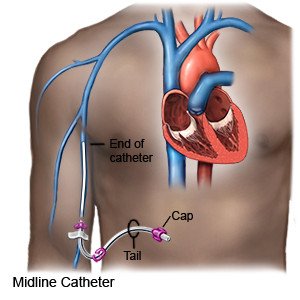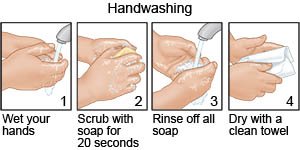How to Care for your Midline Catheter
Medically reviewed by Drugs.com. Last updated on Apr 6, 2025.
What do I need to know about how to care for a midline catheter?
A midline catheter can be kept in place for up to 30 days. You will need to care for the catheter, and for the skin around the catheter site. Proper care is important to prevent damage to the catheter, and to prevent infections.
 |
What can I do to prevent an infection?
The area around your catheter may get infected, or you may get an infection in your bloodstream. A bloodstream infection is called a catheter-related bloodstream infection (CRBSI). A CRBSI is caused by bacteria getting into your bloodstream through your catheter. This can lead to severe illness. The following are ways you can help prevent an infection:
- Wash your hands often. Use soap or an alcohol-based hand rub to clean your hands. Clean your hands before and after you touch the catheter or the catheter site. Remind anyone who cares for your catheter to wash his or her hands.

- Limit contact with the catheter. Do not touch or handle your catheter unless you need to care for it. Do not pull, push on, or move the catheter when you clean your skin or change the dressing. Wear clean medical gloves when you touch your catheter or change dressings.
- Keep the area covered and dry. Keep a sterile dressing over the catheter site. Wrap the insertion site with plastic and seal it with medical tape before you bathe. Take showers instead of baths. Do not swim or soak in a hot tub.
How do I change the dressing and clean the area?
Change the dressing every 3 to 7 days, or as directed. Change the dressing any time it becomes wet, dirty, or moves out of place. Always change the bandage in a clean area that is free of dust. Check your skin every day for signs of infection, such as pain, redness, swelling, and oozing.
- Wash your hands. Use soap and water or an alcohol-based hand rub.
- Put on clean medical gloves and a mask. Pick up each folded glove by its cuff and put it on one at a time. Touch only the cuff when you put a glove on. Do not touch the outside of the gloves with your bare hands. Do not let them touch anything. If someone is helping you, that person also needs to wear a mask and gloves.
- Carefully remove the clear bandage. Unsnap your line from the area holding it in place. Use rubbing alcohol or saline to remove the tape, if needed. Remove your gloves and throw them away. Wash your hands again, and put on new clean medical gloves.
- Open the bandage kit. The kit will contain a sterile disposable pad. Carefully unfold the corners of the pad and lay it out on a clean surface. Empty the contents of the bandage kit away from you onto the pad.
- Open the cleaning pads from the kit. Use a cleaning pad to scrub the area where the catheter is inserted into your skin. Scrub the area as directed. Start at the insertion site and clean outward from it in circles. Let the area dry. Do not blow on your skin to help it dry.
- Use a new cleaning pad to scrub the tubing that comes out of your skin. Use a downward motion to clean the tubing. Do not go up and down the tubing. You might get germs into the tubing when you go back up.
- Secure the line. Place the pad that fits around the insertion site as directed. Place the tape bandage under your catheter line to secure it to your skin. Snap the line in place. Apply a new dressing as directed. If the dressing is clear, make sure you can see the insertion site.
How do I care for the caps and tubing?
Change the caps every 3 to 7 days, or as directed.
- Wash your hands. Use soap and water or an alcohol-based hand gel.
- Twist the caps to remove them from the end of each port. With an alcohol pad, scrub the end of each port in a twisting motion for 30 seconds. Place a new cap on the end of each port.
- Place protective caps over the injection caps, if directed. The caps will protect your catheter from infection when it is not being used.
Call your local emergency number (911 in the US) for any of the following:
- You feel lightheaded, short of breath, or have chest pain.
- You have trouble breathing.
- You cough up blood.
When should I seek immediate care?
- Blood soaks through your bandage.
- Your arm or leg feels warm, tender, and painful. It may look swollen and red.
- You have trouble moving your arm.
- Your catheter falls out.
When should I call my doctor?
- You have a fever or swelling, redness, pain, or pus where the catheter was inserted.
- You see a tear in the tubing of your catheter.
- You see fluid leaking from the insertion site.
- You have questions or concerns about your condition or care.
Care Agreement
You have the right to help plan your care. Learn about your health condition and how it may be treated. Discuss treatment options with your healthcare providers to decide what care you want to receive. You always have the right to refuse treatment. The above information is an educational aid only. It is not intended as medical advice for individual conditions or treatments. Talk to your doctor, nurse or pharmacist before following any medical regimen to see if it is safe and effective for you.© Copyright Merative 2025 Information is for End User's use only and may not be sold, redistributed or otherwise used for commercial purposes.
Learn more about How to Care for your Midline Catheter
Care guides
- De Quervain Release
- Epidural Steroid Injection
- How to Care for your Child's Midline Catheter
- How to Care for your Child's Picc (Peripherally Inserted Central Catheter)
- How to Care for your Picc (Peripherally Inserted Central Catheter)
- Radiofrequency Ablation of the Kidney
- Removal of a Central Line, Picc, or Midline Catheter
Further information
Always consult your healthcare provider to ensure the information displayed on this page applies to your personal circumstances.
